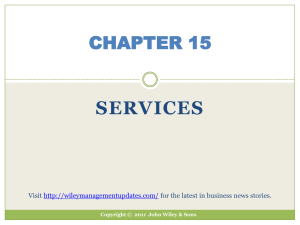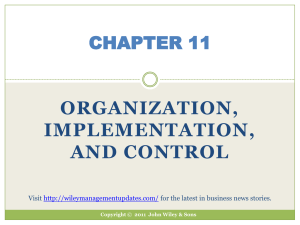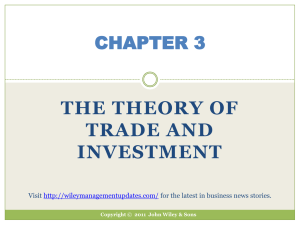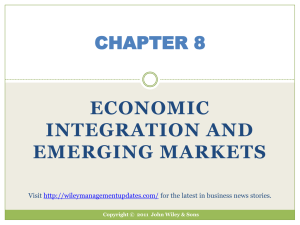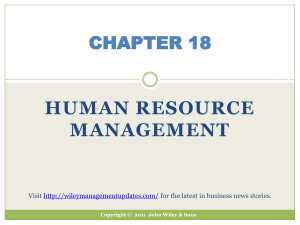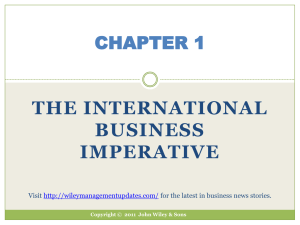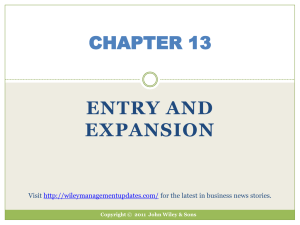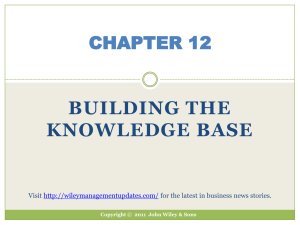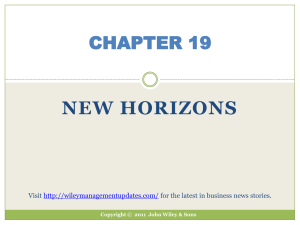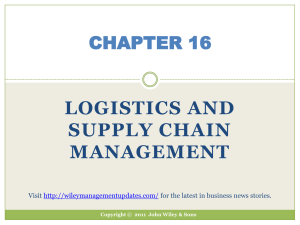Chapter 17
advertisement
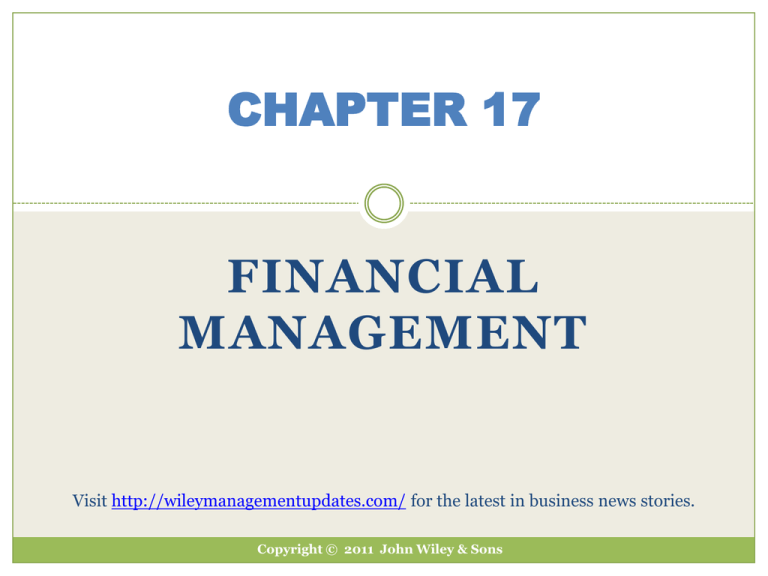
CHAPTER 17 FINANCIAL MANAGEMENT Visit http://wileymanagementupdates.com/ for the latest in business news stories. Copyright © 2011 John Wiley & Sons 1. Understand how value is measured and managed across the multiple units of the multinational firm Chapter 17 2. Examine how international business and investment Learning Objectives 3. Understand the primary decision methods used to activity alters and adds to the traditional financial management activities of the firm evaluate the potential risks and returns of a proposed investment in a foreign country 4. Explore how both operating and financing cash flows are managed within the multinational firm 5. Understand the three primary currency exposures that confront the multinational firm 6. Analyze the process of using goods and services as a medium of exchange in addition to money in international business 7. Examine the primary differences in the taxation of business internationally, and how governments tax firms operating in their markets Chapter 17 2 Czinkota: International Business, 8e What is the Goal of Management? Stockholder wealth maximization – Seeking to maximize the returns to stockholders Corporate wealth maximization – Directs management to consider the financial and social health of all stakeholders Global Financial Goals Maximization of consolidated, after-tax income Minimization of the firm’s effective global tax burden Correct positioning of the firm’s income, cash flows, and available funds Chapter 17 3 Czinkota: International Business, 8e Focus on Ethics: Stockholder Wealth Maximization and Corporate Culture: The Enron Debacle Enron may be the classic tale of how the singular pursuit of profit, in the absence of consideration of other interests, can lead to ruin. Without the healthy balance of wisdom and experience from a time-tested corporate culture, Enron in many ways became a naïve and blind pursuer of stockholder wealth maximization. Many believe that it was it’s corporate culture that led to questionable ethical decisions and ultimately to its demise. Chapter 17 4 Czinkota: International Business, 8e Genus Corporation A sample corporation illustrates how the components fit together and how financial management must make trade-off decisions Genus Corporation is a U.S.-based manufacturer and distributor of extremity-stimulus medical supplies Would have Genus rearrange its profits into the Tax countries having the lowest tax rates Management Would have Genus rearrange its profits into Germany Currency because of the stability of the euro Management Funds Flow Would have Genus rearrange its profits and cash flow to minimize having funds blocked up in China Management Chapter 17 5 Czinkota: International Business, 8e Genus Corporation and Foreign Subsidiaries Genus Corporation Brazil Moderate Tax Unstable Currency Limited Funds Movement Chapter 17 Germany High Tax Stable Currency Free Funds Movement 6 China Low Tax Stable Currency Blocked Funds Czinkota: International Business, 8e Multinational Management at Genus Primary goal is maximization of consolidated profits after tax Consolidated profits are profits of all the individual units of the firm originating in many different currencies Subsidiary financial statements are in local currency Firm’s performance is on basis of earnings per share (EPS) – Consolidated profits after taxes divided by shares outstanding Each affiliate is subject to laws of the country where it is located Financial decisions at Genus Capital budgeting Capital structure Working capital and cash flow management Chapter 17 7 Czinkota: International Business, 8e Trade Financing with a Letter of Credit (L/C) Germany Issues L/C Financing of Trade with L/C Old Growth Pine Lumber Exported Pacific First Bank (U.S.) Draft drawn and payment made Assures that payment will be made Determination of financial soundness Request L/C Yokohama Bank (Japan) Vanport Lumber Company (U.S.) Bill of lading signed Chapter 17 8 Czinkota: International Business, 8e Multinational Investing Capital Budgeting Net present value – The sum of the present values of all cash inflows and outflows from an investment project discounted at the cost of capital Capital budget – The process of projecting the net operating cash flows of the potential investment to determine if it is indeed a good investment Cash Flow Components Initial expenses and capital outlays Operating cash flows Terminal cash flows Decision Criteria – Positive Net Present Value Chapter 17 9 Czinkota: International Business, 8e Weis Markets Announces 2010 Capital Budget Weis Markets, Inc., which owns and operates supermarkets and discount retail centers, announced a capital budget of $102.8 million in 2010, a 27% increase over the year before. The company said that the increased spending would be used to increase and update the store base of the company. This would include up to 3 new stores, 2 expansions and remodeling of 23 existing stores. The company would also use some of the extra capital to increase its investment in technology infrastructure to support the increased sales growth. Source: http://www.ibtimes.com/articles/21691/20100430/weis-markets-inc-wmk-announces-2010-capital-budget.htm Chapter 17 10 Czinkota: International Business, 8e Risks in International Investments Types of Financial Risks: Exchange Risk Interest Rate Risk Combining Interest-Rate and Exchange-Rate Risks A common mistake is not understanding what borrowing and investing in foreign currency really means Borrowing or investing in foreign currencies includes foreign exchange risk Chapter 17 11 Czinkota: International Business, 8e Focus on Politics: Brazil Fighting the Rise of the Real Brazil’s government is applying a tax on Brazilian stocks traded as American depository receipts (ADRs) to stem the rapid flow of capital into Brazilian securities. The move is an effort to close a loophole that allowed investors to buy Brazilian shares overseas and avoid a two percent tax on foreign investments. Chapter 17 12 Czinkota: International Business, 8e Operating Cash Flows and Financial Cash Flows Cash management – Management of cash balances owned by the firm held by banking and other financial institutions Operating Cash Flows are from daily business activities and operations Financing Cash Flows come from the funding activities of the firm (debt or equity) Intrafirm Cash Flows and Transfer Prices Transfer prices occur when a company sells products to its own subsidiaries and affiliates Repayments of loans from subsidiary who funded a project Chapter 17 13 Czinkota: International Business, 8e Cash Management Netting – Cash flow coordination between global units of a corporation so that one smaller cash transfer is made Cash Pooling – Centralizing individual units’ cash flows Lead – Paying a debt early to take advantage of exchange rates Lag – Paying a debt late to take advantage of exchange rates Reinvoicing – Buying goods from one unit and selling them to a second unit to take advantage of favorable exchange rates Internal Banks – A “bank” owned by the company to buy and sell receivables from units Chapter 17 14 Czinkota: International Business, 8e Netting and Cash Pooling of Cash Flows in the Multinational Firm U.S. Parent U.S. $ German Subsidiary € Chapter 17 Cash Flows Move Both Ways Between the Units of the Firm 15 French Subsidiary € Czinkota: International Business, 8e Transaction Exposure Transaction Exposure is the potential for losses or gains when a firm completes a foreign currency transaction Most common type of exchange risk Two conditions are necessary: Cash flow is denominated in a foreign currency The cash flow will occur at a future date Transaction Exposure Management Natural hedging – Cash inflows and cash outflows by currency are matched Contractual hedging – Use of contracts to minimize transaction exposure Forward contract – Agreement that permits the firm to either sell or buy a specific currency at a future date at a known price Hedge – An asset or a position whose value moves in the equal but opposite direction of the exposure Chapter 17 16 Czinkota: International Business, 8e Speculation Speculation occurs when currency positions or financial instruments are purchased (or sold) with the expectation that a specific currency movement will result in a profit Chapter 17 17 Czinkota: International Business, 8e Hedging Against Foreign Exchange Risk For small import and export companies, foreign exchange volatility is one of the most difficult and frustrating aspects of doing business internationally. Hedging is often used to offset foreign exchange risk. An article from GoCurrency.com provides detailed information about hedging, including: • Calculating foreign exchange exposures • How does it work? • Knowing when to hedge • Who should hedge? Source: GoCurrency.com: http://www.gocurrency.com/international-foreign.htm Chapter 17 18 Czinkota: International Business, 8e Transaction Exposure Case: Lufthansa In January 1985, the German airline Lufthansa purchased 20 Boeing 737 jet aircraft The exposure – Lufthansa agreed to pay Boeing $500 million a year later and if the deutschemark continued to fall that would end up being more money to pay in one year The management strategy – Decided to use forward contracts to cover half the exposure The outcome – Since the dollar fell dramatically the company had to pay for the forward contract Chapter 17 19 Czinkota: International Business, 8e Economic Exposure The change in the value of a firm arising from unexpected changes in exchange rates All firms, either directly or indirectly, have economic exposure Impact of Economic Exposure – As diverse as firms’ international structures Economic Exposure Management – Be prepared for the unexpected Chapter 17 20 Czinkota: International Business, 8e Countertrade Countertrade is a sale that encompasses more than an exchange of goods, services, or ideas for money Barter – Direct exchange of goods with no money involved Benefits of Countertrade Disadvantages of Countertrade • Allows the circumvention of price controls • Excellent mechanism to gain entry into new markets • Can provide major growth opportunities for firms • Can provide stability for longterm sales Chapter 17 • May not be efficient • Accounts must be settled on a countryby-country or transaction-bytransaction basis 21 Czinkota: International Business, 8e MIT Study Shows Barter’s Use in Monetary Crisis Dr. David Woodruff of MIT reports that barter’s use was very important after the collapse of the Soviet Union in the late 1990’s. At the time Russia was in a political and economic crisis that lasted a decade. Inflation had destroyed the currency, and there was neither a banking sector to speak of nor a functioning monetary system. Barter was the answer. It was used by individuals, businesses, and the central government. Woodruff says that in 1998 a huge 50% to 75% of exchange in Russian industry took the form of barter. At least onequarter of the revenue collected in 1997 for the federal budget took a non-monetary form. Source: BarterNews.com: http://www.barternews.com/mit_study_shows_barters_use_in_monetary_crisis.htm Chapter 17 22 Czinkota: International Business, 8e International Tax Jurisdictions and Tax Types Tax Jurisdictions Residential Approach – Taxes the international income of its residents without regard to where the income is earned Territorial/Source Approach – Taxes all parties, regardless of country of residency, within its territorial jurisdiction Most countries combine the two approaches to tax foreign and domestic firms equally Tax Types Direct taxes – Taxes applied directly to income Indirect taxes – Taxes applied to non-income items Value-added tax – Taxes applied on the value contributed at each stage of the production and distribution process Chapter 17 23 Czinkota: International Business, 8e Focus on Politics: How High Taxes Make the U.S. Uncompetitive One of the biggest challenges facing the U.S. economy is that it is now a high corporate income tax country. Although the U.S. possessed one of the lowest corporate tax rates for many years, it has stayed relatively constant while most major industrialized countries continually cut tax rates. The higher tax rate has made the U.S. an unattractive country in which to invest. Chapter 17 24 Czinkota: International Business, 8e Income Categories and Taxation Three methods used for the transfer of funds across tax jurisdictions: Royalties – For use of intangible assets Interest – Payment for the capital lent for the financing of normal business activity Dividends – Income paid to shareholders from residual earnings of operations Royalty and interest payments are normally subject to withholding taxes Corporate profits are typically double taxed through corporate and personal taxes Chapter 17 25 Czinkota: International Business, 8e
